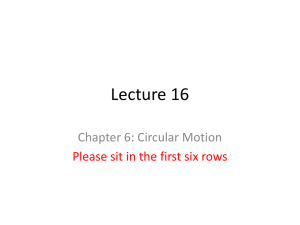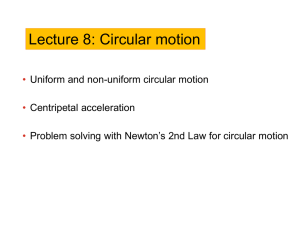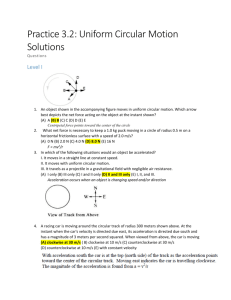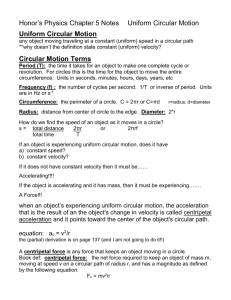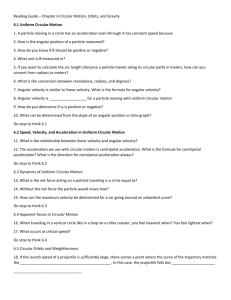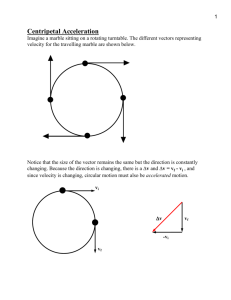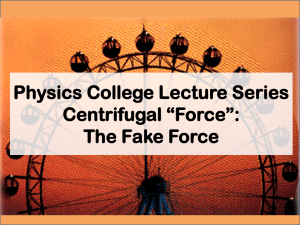Centripetal Force
advertisement
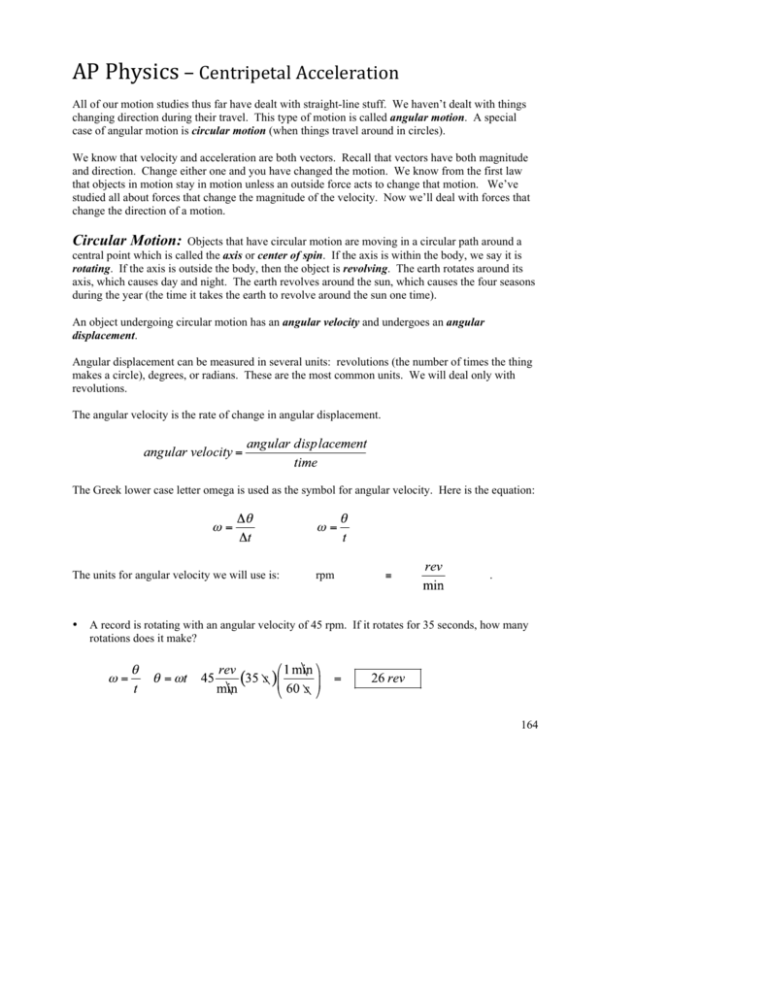
AP Physics – Centripetal Acceleration All of our motion studies thus far have dealt with straight-line stuff. We haven’t dealt with things changing direction during their travel. This type of motion is called angular motion. A special case of angular motion is circular motion (when things travel around in circles). We know that velocity and acceleration are both vectors. Recall that vectors have both magnitude and direction. Change either one and you have changed the motion. We know from the first law that objects in motion stay in motion unless an outside force acts to change that motion. We’ve studied all about forces that change the magnitude of the velocity. Now we’ll deal with forces that change the direction of a motion. Circular Motion: Objects that have circular motion are moving in a circular path around a central point which is called the axis or center of spin. If the axis is within the body, we say it is rotating. If the axis is outside the body, then the object is revolving. The earth rotates around its axis, which causes day and night. The earth revolves around the sun, which causes the four seasons during the year (the time it takes the earth to revolve around the sun one time). An object undergoing circular motion has an angular velocity and undergoes an angular displacement. Angular displacement can be measured in several units: revolutions (the number of times the thing makes a circle), degrees, or radians. These are the most common units. We will deal only with revolutions. The angular velocity is the rate of change in angular displacement. The Greek lower case letter omega is used as the symbol for angular velocity. Here is the equation: The units for angular velocity we will use is: • rpm ≡ . A record is rotating with an angular velocity of 45 rpm. If it rotates for 35 seconds, how many rotations does it make? 164 Linear Speed and Circular Motion: When an object is rotating all points on the object have the same angular velocity. But at the same time each point is also tracing out a circle. If you divide the time it takes to make one revolution into the circumference of the circle that is traced out you get the speed of the point. We call this the linear or tangential speed. The linear velocity is not constant as its direction changes every instant. Calvin’s father is correct about the two points on a record. But, unlike Calvin, this should make perfect sense to you, the sophisticated advanced student of physics. The further a point is from the center of spin, the larger will be its linear speed. This is true for the earth as well. You have a much larger linear speed if you are at the equator than you would have if you were at one of the poles. We can figure out the linear speed of a point using the angular velocity. Speed is distance divided by time, the time it takes to make one revolution is: Let the angular displacement be 1 revolution: This is the period of the rotation, the time it takes to make one revolution. So we now have the time. Here is the equation for speed: The distance is the circumference of the circular path, found for the time. . We plug this in and also the value we 165 So the linear speed is given by: Force and Circular Motion: A ball is attached to a string. The ball is whirled around and around. You can picture this right? In the drawing, we are looking down on the path of the ball from above. If the string breaks at the point shown, what will be the path of the ball? The Physics Kahuna will give you three choices: In order for an object to undergo circular motion, a force must act. Picture an object that has some velocity. What will happen to it if no forces act on it? Well, according to the first law, it will continue to move with a constant velocity. It will follow a straight-line path. To make it change direction a force must act on it. In order to make it changes direction constantly, a force must act on it constantly. What is the direction of the force needed to do this? Well, when you spin something in a circle, what do you have to do? You just pull it towards the center as you go around and around. The object gets accelerated towards the center. We call this the centripetal acceleration. The equation for the centripetal acceleration is: 166 Physics Kahuna Comment: ac is the centripetal acceleration, v is the linear or tangential speed, and r is the radius of the circular path. This equation will be provided to you for the AP Physics Test. • A rotating object has a linear speed of 1.5 m/s. It undergoes a centripetal acceleration of 3.6 m/s2. What is the radius of the mass's circular motion? The force that brings about this acceleration is called the centripetal force. Its direction is also towards the center of the circular path. Centripetal means "center seeking". The centripetal force changes the direction of the object’s velocity vector. Without it, there would be no circular path. The centripetal force is merely a convenient name for the net force that is towards the center. It is always caused by something – it could be caused by the force of gravity, the reaction force between the control surfaces of an airplane with the air, &tc. When you rotate a ball around your head in a circle, the centripetal force is supplied by the tension in the string. What is the source of the centripetal force that causes a racecar to travel in a circular path on the racetrack? The force is brought about by the tires pushing on the racetrack. The friction between the road and the tire is very important, so race tires are designed to maximize friction. What is the source of the centripetal force required to make the earth revolve around the sun? This is where the apple falling on Newton story fits in. Before Newton no one could explain the orbits of the planets and moons. Newton, the story goes, was relaxing under an apple tree pondering the problem of the moon’s orbit. He knew that there had to be a force acting on the moon to accelerating it towards the earth, but had no idea what was the source of the force. Then he saw an apple fall and the simple solution struck him like the old thunderbolt. Just as the earth’s gravity reached out and made the apple fall, so it reached out and made the moon fall. Thus, the force that keeps the planets and moon following their orbital paths is gravity. The AP Test equation sheet will not give you the equation for centripetal force. It does give you the equation for centripetal acceleration. It also gives you the equation for the second law. Using these two equations you can easily derive the formula for centripetal force. Here’s how to do it: so plug in the value of the centripetal acceleration: 167 That’s all there is to it. • 1.2 kg stone is attached to a 1.3 m line and swung in a circle. If it has a linear speed of 13 m/s, what is the centripetal force? • A car is traveling at a constant speed and makes a turn with a radius of 50.0 m. Its speed is15.0 m/s. Find the minimum coefficient of friction needed to keep the car traveling along the path. Let’s look at the FBD: The frictional force must equal the centripetal force. The centripetal force is given by: We know that this must equal the frictional force. We also know that the frictional force is: Assume the road is flat, so n = mg Set the two equal to each other and solve for the coefficient of friction: • A child twirls a yo yo. If angle of the cord with the vertical is 30.0°, find ac. Look at the forces in the y direction: 168 ∑ Fy = 0 The horizontal component of T is the centripetal force. Plug into equation for T: We know that: so Centrifugal force: You may have heard of the centripetal force before you studied physics. It is possible. Most people don’t use the term however. Instead they talk about the centrifugal force. Just what the heck is that? Okay, you’ve seen the word “centrifugal force”, now forget it! It’s terribly bad form for a physicist such as yourself to use such a naïve term. Here’s the deal. The centrifugal force is the thing that people blame for the feeling that things seem to be pushed away from the center of spin during rotation. You place a coin on a turntable and then spin it really fast. What happens to the coin? In your mind you picture the coin flying straight away form the center of the record. The individual who had not studied physics would say this was because of the centrifugal force. Here is an important concept: The centrifugal force is a fictional force. There is no actual force that is pushing away from the center of a rotating system. You feel this “centripetal force” when you are a passenger in a car that makes a turn. When the car enters the turn, you feel as if you have been pushed into the door, away from the center of the circular path the car is making. So you think, “Hey, I’m being pushed into the door so there must be a force pushing me away from the center of the turn.” That’s certainly how you feel at any rate. Remember the problem at the beginning of this distinguished paper? About the path a ball would follow if the string were to break? You had you three of your basic choices: 169 The correct choice, you’ve hopefully (actually, the Physics Kahuna should say “it is to be hoped”, but that sounds very pompous, so we won’t say that) figured out that the correct path is B. Why? Well at the point in the circle where the string breaks, the ball has a velocity that is tangent to the circular path. The string is providing the centripetal force – pulling the ball towards the center. The ball wants to follow the tangential path because of the first law, but the string won’t let it. The string, via the tension it exerts, pulls the ball towards the center, changing the direction of its motion and making it follow the circular path. When the string breaks there is no longer any force to change its direction, so the ball travels in a straight-line path that is tangent to the circle as in the B drawing in accordance with the first law of motion. This is sort of what is going on in the car with the passenger. The passenger wants to travel in a straight-line path at a constant speed in accordance with the law, the first law to be exact. The car however has different ideas. It decides to go in a circular path. It’s the tires pushing it toward the center exerting a force to make it all happen. So the car changes direction, but you, the passenger, do not. No force is acting on you. So you go forward in your original direction until you push into the door, which then pushes you toward the center and you then go in a circle as well. The third law rears it head – you push into the door and the door pushes into you. You feel like you are being pushed into the door, even though there is no real force doing this. It’s just the reaction force to you pushing into the door. This is the so called centrifugal force, this sensation of being pushed away from the center. If the centrifugal force was real, i.e., there was a force pushing you away from the center of the circular path, then if the door were to suddenly pop open you would fly straight away from the center of the circular path. But of course that does not happen. You would travel in a tangential path. The centripetal force is real, the centrifugal force is not. Centripetal Force and Gravity: The Physics Kahuna did a silly demonstration involving a bucket of water that was spinning in a vertical circle. The water stayed in the bucket and did not fall out. So what was the deal? Does spinning something in a vertical circle somehow cancel out gravity? Well, no, gravity is a force that cannot be stopped or canceled. It is always there, anytime you have the appropriate masses. The water does fall, it falls but the bucket falls 170 with it and catches it. This only works if the bucket is moving fast enough to catch the water. If the bucket is too slow, then the water will fall out of it. The minimum linear speed for this is called the critical velocity. Critical velocity ≡ minimum velocity for an object to travel in vertical circle and maintain its circular path against the force of gravity. The same thing is needed for satellites in orbit around the earth or planets in orbit around the sun. They too must travel at the critical velocity. The critical velocity formula is not provided on the AP Test, but it is very simple to figure out. You just set the centripetal force equal to the weight of the object that is in circular motion. If the two forces are equal, then the object won’t be able to “fall out” of the bucket. and Set them equal to each other: So here is the critical velocity • A carnival ride travels in a vertical circle. If the ride has a radius of 4.5 m, what is the critical velocity? AP Test Question Time: • A heavy ball swings at the end of a string as shown here, with negligible air resistance. Point P is the lowest point reached by the ball in its motion, and point Q is one of the two highest points. (a) On the following diagrams draw and label vectors that could represent the velocity and acceleration of the ball at points P and Q. If a vector is zero, explicitly state this fact. The dashed lines indicate horizontal and vertical directions. i. Point P 171 ii. Point Q (b) After several swings, the string breaks. The mass of the string and air resistance are negligible. On the following diagrams, sketch the path of the ball if the break occurs when the ball is at point P or point Q. In each case, briefly describe the motion of the ball after the break. i. Point P ii. Point Q Okay, here we go. Let’s answer the questions. (a) On the following diagrams draw and label vectors that could represent the velocity and acceleration of the ball at points P and Q. If a vector is zero, explicitly state this fact. The dashed lines indicate horizontal and vertical directions. i. Point P Many foolish AP Physics students forgot about the centripetal acceleration when they labeled the ball at point P. You wouln’d forget something like that would you? ii. Point Q At point Q the ball has come to rest (for an instant) and so its velocity is zero. The only acceleration acting on it is the acceleration of gravity. (d) After several swings, the string breaks. The mass of the string and air resistance are negligible. On the following diagrams, sketch the path of the ball if the break occurs when the ball is at point P or point Q. In each case, briefly describe the motion of the ball after the 172 break. i. Point P At point P the ball is at its lowest point in the path. When the centripetal force disipears (the broken string, right?) the ball continues to move with the velocity it had at this point, which is horizontal. So its path looks like the projectiles we studied that started out with a horizontal velocty. ii. Point Q At point Q the ball is at rest so when the string breaks it simply falls straight down. 173

